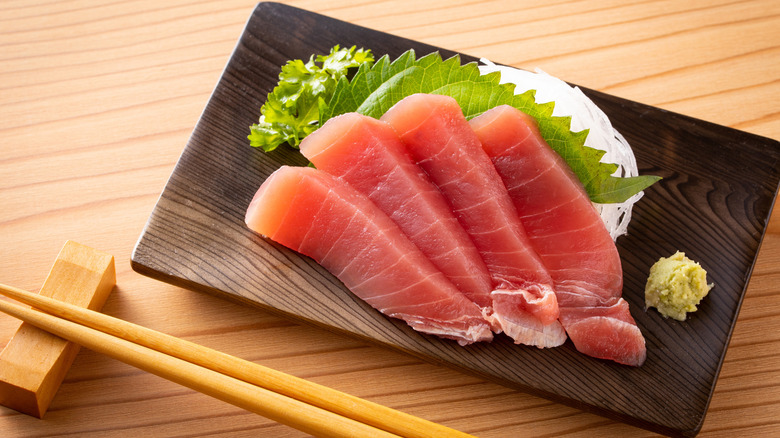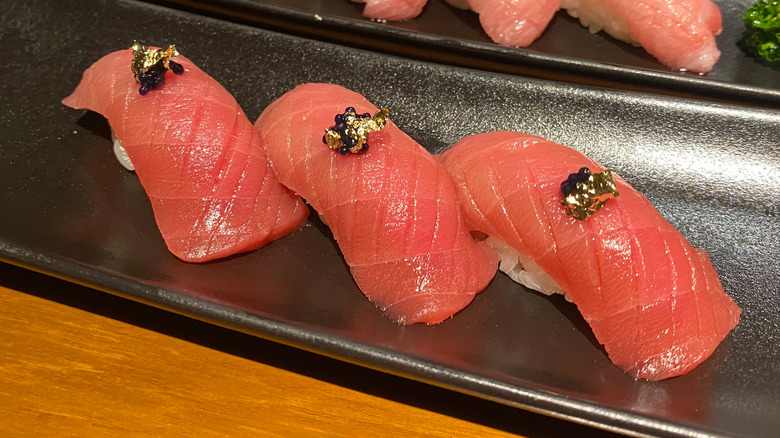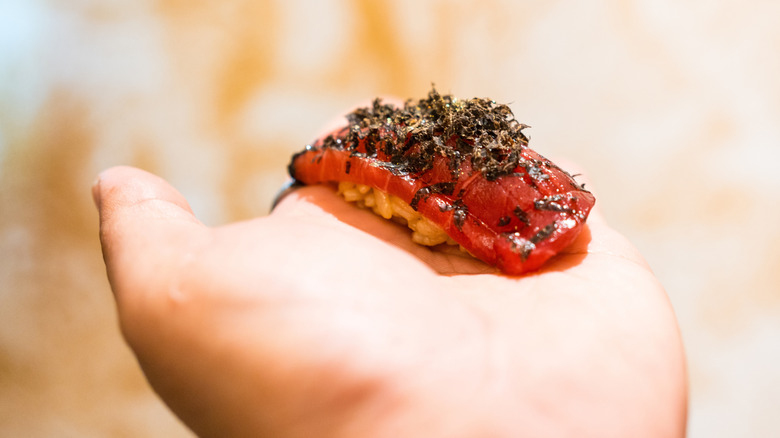The 3 Most Common Cuts Of Tuna For Sashimi
There are a few major differences between sushi and sashimi, but tuna is a common ingredient in both — and it can be prepared in a variety of ways. Sashimi is a traditionally Japanese dish consisting of raw, thinly-sliced fish. Proper sashimi is served by itself, but you might occasionally see it scattered atop a bowl or plate of white rice (this is actually called chirashi, though some people in the United States use the terms interchangeably).
Whether you prefer sashimi on its own or with something else, different types and cuts of tuna may be used. Bluefin tuna is the most expensive sushi-grade tuna you can buy, but it has a higher mercury content than other tuna types like yellowfin.
That said, bluefin and yellowfin sushi-grade tuna come in three common sashimi cuts: otoro, chutoro, and kami. Each type comes from a different section of the fish and has a unique flavor and texture, with some used more commonly than others.
Otoro is the highest-quality tuna cut
If you're looking for the absolute best cut of tuna (whether it's bluefin or yellowfin), you'll want to eat otoro. Otoro is taken from the inside of the tuna's belly. The belly of the tuna is the fattiest area, meaning otoro has plenty of fat on it.
Much like pork belly, this gives the otoro a melt-in-your-mouth tender texture and rich flavor. It has a hint of sweetness to it, too, offering the perfect balance to the richness. You can sometimes pay more than $200 per pound for bluefin otoro, depending on where you get it and its availability.
Chutoro is the middle-ground of fat and lean tuna
Chutoro serves as the mid-level tuna between fatty otoro and lean akami; it's referred to as medium-fatty tuna. It's not quite as rich as otoro, but it blends fatty pieces with those slightly leaner, giving a good mix of each flavor type. It's found between the tuna's back and stomach.
Chutoro is common in sashimi, but you might also find it seared on various steakhouse menus because of its rich, balanced flavor. You'll pay around $100 per pound of bluefin chutoro. Interestingly, there is very little chutoro on a single tuna; one serving of sashimi is usually all the chutoro from one fish.
Akami is the leanest part of the tuna
If you order sashimi from your typical takeout sushi spot, you're likely eating akami. While it's still a high-quality cut of fish, this red tuna meat is less expensive than otoro and chutoro because it's leaner and more widely available.
Akami makes up most of the tuna's meat, so it's not as sought-after as the other options. You might pay somewhere between $30 and $60 per pound of bluefin akami, making it substantially more affordable than chutoro and otoro. While all three cuts of sashimi tuna are delicious (whether bluefin or yellowfin), it's important to know that leaner cuts like akami have higher mercury content than fattier otoro.



